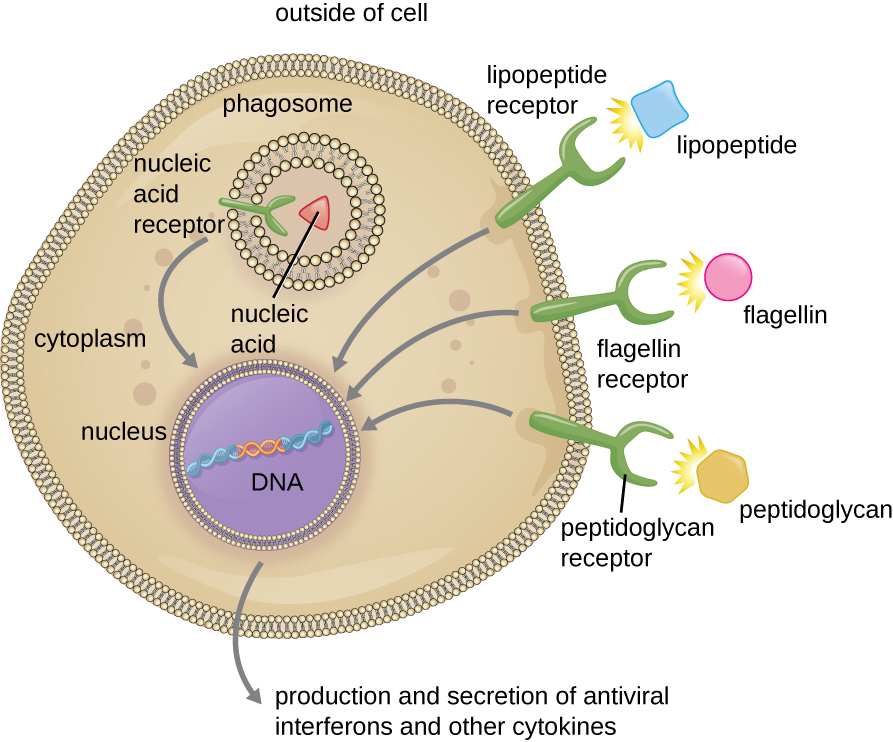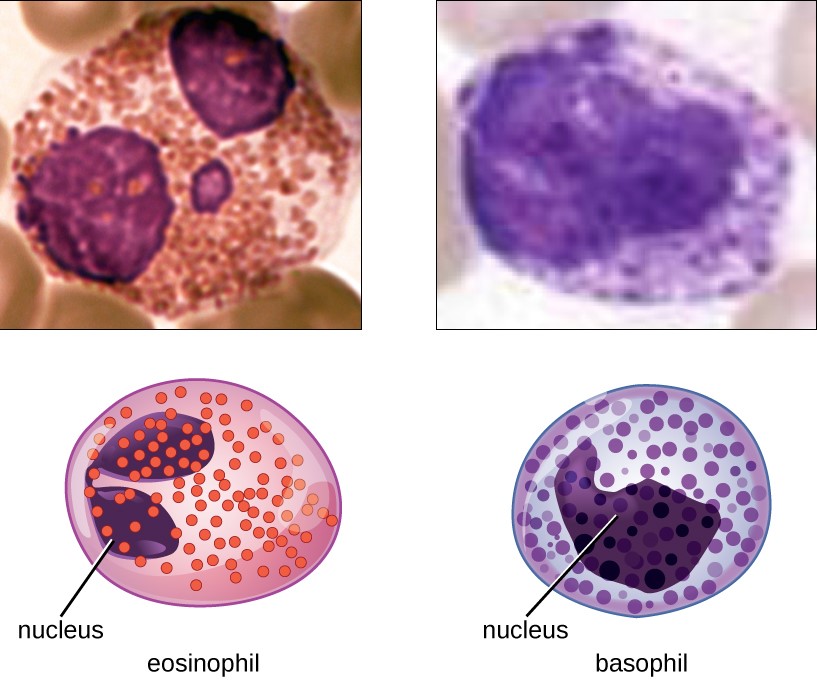Playlist
Show Playlist
Hide Playlist
Inflammatory Signaling and Inflammasomes
-
Slides Innate Immune System.pdf
-
Download Lecture Overview
00:01 It’s no good simply recognizing that there’s a threat. 00:04 The cells of the immune response need to respond to that threat. 00:07 This is where signaling is required so that genes in the nucleus of the immune system cell become activated in order to initiate the response. 00:19 Looking at an example of a cell surface Pattern Recognition Receptor, here you can see on the surface of this immune system cell, Pattern Recognition Receptor which is associated with a molecule called MyD88. 00:36 Following recognition of a PAMP by the Pattern Recognition Receptor, a signal is initiated which involves several different molecules- IRAK, TRAF6, TAK1, IKK. 00:55 And the consequence of this recognition and signaling event is that the molecule IKK phosphorylates a molecule called IKB, which is the inhibitor of NFkB. 01:16 NFkB is a transcription factor. 01:20 Transcription factors bind to genes in the nucleus. 01:24 But NFkB in this diagram, you will see is not present in the nucleus, it’s present in the cytoplasm. 01:31 And the reason that it’s in the cytoplasm is its being held there by the inhibitor of NFkB, IkB. 01:39 And IKK is a kinase, an enzyme that phosphorylates IkB. 01:48 And when IkB becomes phosphorylated, it ends up being degraded, and that means that it releases the NFkB from being held in the cytoplasm. 02:01 And the NFkB can then translocate into the nucleus and initiate gene transcription. 02:10 And multiples genes will be activated as a consequence of recognition of Pathogen-Associated Molecular Patterns by the Pattern Recognition Receptor. 02:25 These will include genes for cytokines, for antimicrobial molecules, and for various adhesion molecules that are required for cells of the immune response to leave the blood circulation and get into the site of the infection. 02:43 Following activation of these genes subsequent to recognition of Pathogen-Associated Molecular Patterns by the Pattern Recognition Receptor, there needs to be the generation of structures that are called inflammasomes. 02:59 As you can see, following gene transcription in this particular example, the preliminary forms of two cytokines have been produced, Pro-Interleukin-1β and Pro-Interleukin-18. 03:16 These are precursors of the active form of these cytokines. 03:22 But in order to activate them, we need to generate this structure called the inflammasome. 03:28 The inflammasome is generated just like the signaling, initially we saw through the Pattern Recognition Receptor, that the inflammasome is generated following recognition of PAMPs and DAMPs. 03:43 There are in fact several different types of inflammasome. 03:46 We’re going to look at the NLRP3 inflammasome. 03:51 So this molecule, NLRP3 becomes associated with two other molecules, one of which is called ASC and the other of which is Pro-caspase-1. 04:03 And following signaling through Pattern Recognition Receptors and other signaling events that occur following encounter with DAMPs or PAMPs, this structure, the inflammasome is generated. 04:21 And the purpose of this structure is to activate Pro-caspase-1 into an active caspase-1. 04:31 And this active caspase-1 is now able to activate Pro-IL-1 and Pro-IL-18 to produce the active forms of these two cytokines - Interleukin-1β and Interleukin-18. 04:49 And these cytokines, belong to a group of cytokines that we call pro-inflammatory cytokines. 04:58 They help generate inflammation. 05:02 So following the conversion of Pro-IL-1β and Pro-IL-18 into their active forms, these two pro-inflammatory cytokines will be released from the cells and help to mediate inflammation. 05:15 Hence the name, the inflammasome.
About the Lecture
The lecture Inflammatory Signaling and Inflammasomes by Peter Delves, PhD is from the course Innate Immune System. It contains the following chapters:
- Signaling from Cell Surface PRR
- Generation of the Inflammasome
Included Quiz Questions
Which of the following is NOT part of the signaling pathway triggered by the binding of the pathogen-associated molecular patterns to the pattern recognition receptors?
- C-myc
- Myeloid differentiation primary response 88 (MyD88)
- NF-kB
- IkB
- IκB kinase (IKK)
Which of the following best describes the role of IκB kinase (IKK) in the signaling pathway triggered by the binding of the pathogen-associated molecular patterns to the pattern recognition receptors?
- Allows separation of NFkB from its inhibitor
- Allows binding of NFkB to its inhibitor
- Allows NFkB to exit the nucleus
- Degrades NFkB
- Inhibits NFkB
Which of the following is the CORRECT sequence following the presentation of the pathogen-associated molecular patterns?
- Binding to PRR -> activation of signaling pathway -> gene transcription
- Activation of signaling pathway -> binding to PRR -> gene transcription
- Gene transcription -> activation of signaling pathway -> binding to PRR
- Binding to PRR -> gene transcription -> activation of signaling pathway
- Gene transcription -> binding to PRR-> activation of signaling pathway
Which of the following regarding the role of the inflammasome is most accurate?
- It activates pro-inflammatory cytokines.
- It inhibits pyroptosis.
- It decreases the inflammation caused by the innate immune system.
- It binds to pathogen-associated molecular patterns.
- It recognizes damage-associated molecular patterns.
Customer reviews
5,0 of 5 stars
| 5 Stars |
|
1 |
| 4 Stars |
|
0 |
| 3 Stars |
|
0 |
| 2 Stars |
|
0 |
| 1 Star |
|
0 |
Dr Delves explains in very clear ways, very complex matters. I appreciate the practical examples used during his lectures. He is clear, to the point and really comprehensive.





